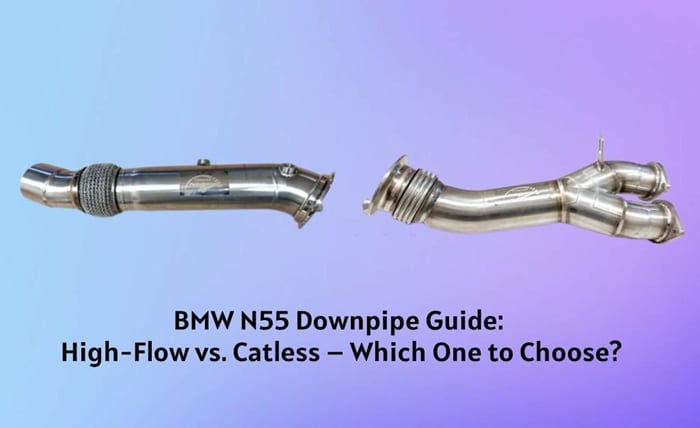
While your BMW N55 has amazing potential, the stock downpipe is restricting its performance. If you want a faster turbo spool, a deeper exhaust sound, and real power improvements, you should consider an aftermarket BMW N55 downpipe. Now, the question is, should it be high-flow catted or full catless?
Swapping an aftermarket downpipe is one of the most impactful modifications you can make, it just comes down to which option to choose. Are you confused about which one to choose? Keep reading to make a proper decision.
Understanding The Downpipe of N55
An N55 engine’s downpipe is an essential part of its exhaust system. It is the duct that goes from the turbocharger to the rest of the exhaust system, and it helps with the vehicle’s performance, sound, and exhaust flow rate in general.
Types of Downpipes for the N55
Let’s talk about the most common types of downpipes you can use in a BMW N55.
Catted Downpipe (High-Flow)
A high-flow catted downpipe comes with a catalytic converter with fewer exhaust gas movement restrictions. As a result, you get a significant performance boost.
- Features a high-flow catalytic converter.
- Improves performance and emission levels.
- Minimizes the possibility of a check engine light (CEL) coming on.
Catless Downpipe
As the name suggests, there is no catalytic converter, offering the best exhaust gas flow and the highest performance boost.
- Eliminates the catalytic converter entirely.
- It provides maximum performance and sound enhancement.
- Increases chances of triggering a CEL and failing the emission test.
N55 Downpipe Performance Comparison
Here is a comparison table that will give you a clear idea about the performance of catted and catless downpipes for your N55:
| Category | High-Flow Catted Downpipe | Catless Downpipe |
| Power Gains | 15- 25 WHP gain with 20- 30 lb-ft torque increase | 25- 40 WHP gain with 30- 45 lb-ft torque increase |
| Turbo Spool | 200-300 RPM faster | 300-500 RPM faster |
| Emissions Legality | Legal in most states | Not legal in the streets |
| CEL Risk | With standard 200-cell cats, the risk is low | Without ECU tuning or O2 spacer, the risk is high |
| Sound | A deep tone with a moderate boost in volume | Loud, aggressive, and has more turbo noise |
| Rasp/Droning | Minimal | Possible, depending on the exhaust |
| Best Usage | Daily drivers, street usage, and emission compliance | Loud setups are ideal for track use, drawing maximum power |
| Installation Difficulty | Moderate and O2 sensors may need adjustments | Same as high-flow |
| Tuning Requirements | Optional but recommended | Tuning is a must |
Which N55 Downpipe is Ideal for You?
The proper way to address a high-flow catted versus a catless downpipe is to understand your goals, budget, and local laws. Here is the complete breakdown that can help you make a decision.
Select HIGH-FLOW CATTED Downpipe If You:
Wish for a performance increase while still remaining emissions compliant (the majority of states pass smog).
- Prefer a sportier and much deeper exhaust note, without getting a drone or excessive rasp.
- Tend to drive on a daily basis and appreciate balance in an upgrade (decent amount of power and higher spool without getting carried away).
- Would prefer not to have to deal with CEL (Check Engine Light) problems (good quality 200-cell cats make this easier).
- Intend to pair with stock or valved exhaust (helps keep noise at a decent level).
- Best For: Street-driven N55s, daily drivers, and people who live in areas with strict emissions controls (CA, NY, EU).
Choose CATLESS Downpipe If You:
Wish to have the highest amount of horsepower & the fastest response from the turbo (a must for a big turbo or a track build).
- Don’t mind the legality of emissions (or reside in a location where enforcement is not strict).
- Enjoy a much deeper, loud, and aggressively tuned exhaust sound (turbo whistle, pop, raw tone).
- Already have or intend on getting a tune to eliminate the Check Engine Light issues.
- Want to spend less money (catless pipes usually have a lower price).
- Ideal For: Track cars, bolt-on (FBO) setups, or people who want the most hardcore setup possible.
Are you still confused? Here is a quick checklist that will make it as easy as it gets:
| Your Priority | Ideal Choice |
| Emission Compliance | High-Flow Catted |
| Max Power & Fastest Spool | Catless |
| Budget-Friendly | Catless |
| OEM + Sound (No Drone) | High-Flow Catted |
| Big Turbo/Race Build | Catless |
| Daily Driving/ Street Use | High-Flow Catted |
So, if you are building a racing car only for tracks, a catless will bring you the best outputs. On the other hand, if you want a cool car to drive regularly, then a high-flow catted downpipe is the ultimate choice.
Conclusion
In a nutshell, the overall decision depends on your use case and preference. If your target is to squeeze out every last bit of performance from your N55 engine, then a catless downpipe is your only option.
However, it breaks emission laws, so you can’t drive it on public streets. These cars are only allowed on the tracks. But if you want to follow the emission rules and drive a powerful beast every day, then a high-flow catted downpipe is the ideal choice.




